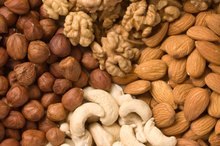Zinc, Magnesium & Vitamin B6
Vitamin B6, zinc and magnesium all interact with each other in carbohydrate, fat and protein metabolism and proper DNA synthesis. Vitamin B6 is a water-soluble vitamin that cannot be stored in your body. Zinc is found mostly in your blood plasma and liver, while magnesium is stored in your bones. Dietitian Ellen Coleman recommends that you obtain these nutrients from a variety of plant sources, because plants contain other vitamins and minerals that interact with these three nutrients for functions and growth development.
Functions
You body needs vitamin B6 for over 100 enzyme functions that are involved with metabolism. In the form of pyridoxal phosphate, vitamin B6 carries out protein synthesis of hemoglobin formation in your red blood cells, synthesis of white blood cells and developing neurotransmitters.
Zinc also regulates protein synthesis and proper growth development. According to the Linus Pauling Institute at Oregon State University, it is also a component of an antioxidant called superoxide dismutase, or SOD, which protects cells from free radical damage. Zinc also plays a role in storing and releasing insulin, moving vitamin A from the liver and keeping your blood pH in balance.
Besides maintaining bone structures, magnesium works with potassium in conducting nerve impulses; metabolizing carbohydrates, fats and proteins; and DNA and RNA synthesis. It also regulates blood calcium balance and helps vitamin D absorb calcium and phosphorous into your bones.
Sources
The Amount of Calcium and Magnesium for a 70-Year-Old Woman
Learn More
Biologist George Mateljan, author of "World's Healthiest Foods," recommends that you get your vitamin B6, zinc and magnesium mostly from plant-based foods, such as fortified whole-grain cereals, whole-grain breads and pastas, green leafy vegetables, nuts and seeds. They are low in calories, contain fiber and an abundance of other vitamins and minerals, and cost less than meat and dairy products. However, the best sources of zinc are from animal sources such as beef, liver, seafood and eggs.
Daily Recommendations
Dietitian Ellen Coleman recommends that you take 1.3 mg of vitamin B6 daily, and 1.7 mg if you are over the age of 50. For zinc, take 11 mg a day if you are a man and 8 mg a day if you are a woman. For magnesium, take between 320 to 400 mg a day. If you have certain chronic diseases, are pregnant or in puberty, the recommendations may vary from these standard ones.
Toxicity
What Are the Causes of Acne Onset in Woman Over 60 Years of Age?
Learn More
Too much of any vitamin or mineral can cause diseases and other disorders. An overdose of vitamin B6 -- over 100 mg a day -- causes irreversible nerve damage, while too much zinc -- 1 to 2 g a day -- causes your body to absorb less copper into your bloodstream. This causes copper deficiency, which causes anemia, collagen breakup and lowered immune system. Too much magnesium, although it is rare in most Westernized nations, have very few symptoms in the rare cases of magnesium overdose. According to former nutrition professor Gordon Wardlaw of Ohio State University, patients who take concentrated sources of magnesium from magnesium-containing drugs can develop extreme nausea, vomiting, low blood pressure and cardiovascular problems.
Deficiencies
Vitamin B6 deficiency causes similar symptoms to magnesium toxicity in addition to tingling sensations in your fingers, hands and feet. According to Wardlaw, lacking enough vitamin B6 in your diet can also cause cardiovascular diseases, because your body needs the vitamin to convert a protein called homocysteine into a usable protein called methionine. Too much homocysteine in your body can cause atherosclerosis, even at a young age.
Too little zinc causes growth retardation, underdeveloped sex organs and hormones, skin disorders, and weak bones and muscles. Magnesium deficiency causes muscle weakness and cramps, irritability, mental derangement, nausea and irregular heartbeat and blood pressure.
Related Articles
References
- "World's Healthiest Foods"; George Mateljan; 2006
- "Linus Pauling Institute"; Zinc; December 2003
- "Perspective in Nutrition"; Gordon M. Wardlaw; 2002
- "Ultimate Sports Nutrition"; Ellen Coleman; 2004
Writer Bio
Nick Ng has been writing fitness articles since 2003, focusing on injury prevention and exercise strategies. He has covered health for "MiaBella" magazine. Ng received his Bachelor of Arts in communications from San Diego State University in 2001 and has been a certified fitness coach with the National Academy of Sports Medicine since 2002.









